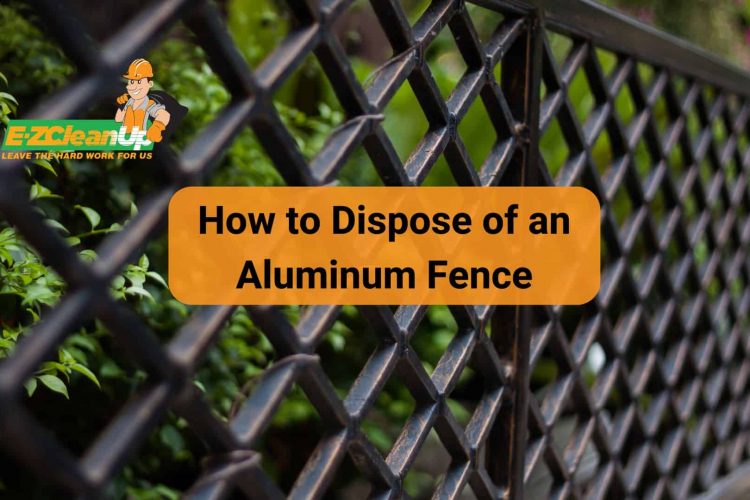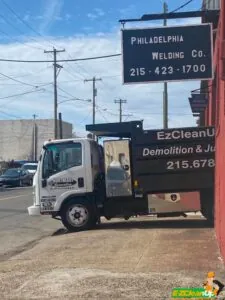When deciding on methods to handle the disposal of your old aluminum fence, assess its condition, dismantle it carefully, and consider recycling, selling it as scrap, or hiring a removal service. You can also creatively repurpose it or donate it to local projects for community use.
Here’s a more thorough look at your options and the processes involved in how to dispose of an aluminum fence.
Preparation for Disposal
This evaluation will dictate the most suitable disposal method, be it recycling, donating, or discarding as waste. The key considerations for fence assessment include the following:
- Integrity and Damage: Check for any signs of corrosion, bends, or significant damage to the fence panels and posts. Aluminum fences are generally low maintenance and resist rust, but physical damage from impacts or harsh weather conditions can affect their structural integrity.
- Cleanliness: Ensure the fence is free from dirt, grime, and debris. A simple wash is often enough to prepare it for the next steps, whether it’s re-use or recycling.
- Completeness: Verify that all components are accounted for, including panels, posts, and any decorative elements like rings or finials. Missing parts may affect the feasibility of certain disposal options, like donation or resale.
Dismantling Your Aluminum Fence
Dismantling an aluminum fence is a structured process that ensures safe removal and prepares the material for disposal or recycling.
Here’s a guide on how to efficiently dismantle your aluminum fence:
- Preparation: Before starting, it’s crucial to wear appropriate personal protective equipment, such as gloves and goggles, to prevent injuries. Clear the area around the fence to facilitate easy access and movement.
- Removing Gates: Start by detaching the gates from the fence. Use a screwdriver to remove the hinges and any other hardware connecting the gates to the fence posts. This makes the subsequent steps easier by reducing the weight and size of the fence structure.
- Detaching Panels: Once the gates are removed, focus on the fence panels. If preserving the panels isn’t a priority, you can cut them at the posts using a reciprocating saw or hand saw. However, if you intend to reuse or donate the fence, carefully unscrew the panels from the posts to avoid damaging them.
- Post Removal: The most challenging part of dismantling an aluminum fence is removing the posts, especially if they are cemented into the ground. For non-cemented posts, you might be able to pull them out with manual force or with the help of a lever. For cemented posts, dig around the post to expose the concrete base, then either use a jack to lift the post out or break the concrete with a sledgehammer.
Sorting and Organizing Materials
After dismantling an aluminum fence, sorting and organizing the materials is crucial for efficient recycling or disposal:
Sorting Materials:
- Separate Non-Ferrous from Ferrous Metals: Utilize a magnet to differentiate between non-ferrous metals like aluminum, which are not magnetic, and ferrous metals, which are. This separation is important because scrap yards value these metals differently and may pay less if they are mixed.
- Organize by Metal Type: Keep different metals in separate containers. Mixing metals can complicate the recycling process and potentially lead to receiving the price of the least valuable metal in the mix.
Cleaning and Preparing for Recycling:
- Clean the Materials: Ensure that all aluminum parts are free from non-metal attachments and contaminants like plastic, dirt, or other debris. This helps in obtaining a better price and facilitates the recycling process.
- Cut Down Large Pieces: If the fence panels or posts are large, cutting them into smaller pieces can help in handling and may be required by some recyclers to fit into their machines.
Safety Measures:
- Wear Protective Gear: During the sorting and cutting process, wear appropriate safety equipment such as gloves, goggles, and sturdy shoes to protect against sharp edges and injuries.
- Proper Handling: Aluminum is generally lightweight, but handling large sections can still pose risks. Use proper lifting techniques and, if necessary, seek help to move bulky items.
Options for Disposing of an Aluminum Fence
Here are your top options when disposing of an aluminum fence:
1. Recycling
Recycling aluminum saves around 95% of the energy required to produce new aluminum from raw ore. This significant energy savings underscores the importance of recycling materials like aluminum, which can be recycled indefinitely without degradation in quality.
Finding the right recycling facility for disposing of an aluminum fence is a practical and environmentally responsible option. Here’s how to approach it:
- General Recycling Facilities: Many local recycling centers accept aluminum because of its high recyclability. You can use resources like Earth911 to search for recycling options in your area. Enter “aluminum” along with your zip code to find nearby facilities that can process this material.
- Scrap Metal Buyers: For larger quantities of aluminum, such as an entire fence, scrap metal yards can be an excellent option. These facilities often pay by weight, and the current price of aluminum can make this a financially viable option. Prices and acceptance criteria can vary, so it’s beneficial to call ahead and confirm.
- Municipal Services: Check with your local government or waste management services to see if they offer recycling programs or partnerships with facilities that accept aluminum.
Many recycling centers offer payment for scrap aluminum. The rate can vary based on market prices. But recycling not only helps you financially but also reduces landfill waste and conserves resources.
2. Selling Scrap Aluminum
Selling scrap aluminum from a dismantled fence can be a financially rewarding option if you have significant quantities. Here’s how to go about it:
- Finding Scrap Yards: Locate nearby scrap yards that purchase aluminum using resources like iScrap App or local directories. Prices may vary, so consider contacting multiple facilities to get the best rate.
- Preparing Aluminum for Sale: Removing any attached non-aluminum parts, such as screws or nails, and cleaning off any paint or debris can increase the purity of the scrap, which makes it more valuable.
- Understanding Market Prices: Keep an eye on current scrap aluminum prices, as they can change daily. Tools like the iScrap App provide updates on prices and can help you decide the best time to sell based on market trends.

3. Hiring a Professional Removal Service
For those looking for a hassle-free disposal method, hiring a professional removal service like us at EZ CleanUp can be an efficient solution. We specialize in the removal of bulk waste, including aluminum fencing. Plus, we ensure all materials are recycled or disposed of responsibly.
Choosing a service like EZ CleanUp supports eco-friendly practices, as we focus on recycling materials whenever possible to minimize environmental impact. This option also removes the burden of manual labor and logistics from the homeowner, which makes it a convenient choice for those who prefer a full-service approach.
Alternative Uses for Old Aluminum Fences
Repurposing or upcycling old aluminum fences into home and garden projects is an innovative way to reduce waste while enhancing your living space.
Here are some creative ideas to transform your discarded aluminum fences into functional and decorative items:
Garden Trellis and Vertical Planters:
- Support for Climbing Plants: Use sections of an aluminum fence as trellises for climbing plants like ivy, roses, or grapevines. The sturdy structure provides excellent support for these plants to grow vertically.
- DIY Vertical Garden: Attach small containers or pots to the fence panels to create a vertical garden for herbs or succulents. This can be an artistic and space-saving way to add greenery to your balcony or patio.
Decorative Yard Art:
- Custom Sculptures: Cut and weld the aluminum into various shapes to create unique sculptures for your garden. These can serve as focal points or fun elements that personalize your outdoor space.
- Sun Catchers and Wind Chimes: Hang colorful glass pieces, crystals, or other reflective materials from the fence sections placed strategically to catch light or produce melodious sounds when the wind blows.
Functional Home Items:
- Fence to Furniture: Transform fence panels into outdoor tables, chairs, or benches by adding wooden tops or cushions. The metal base will be durable and weather-resistant for outdoor use.
- Decorative Frames and Panels: Use smaller sections of the fence to frame garden mirrors or as a stylish backdrop for outdoor seating areas. They can also be painted and hung as artwork.
Boundary and Privacy Enhancements:
- Privacy Screens: Stand panels up to act as privacy screens around a patio, hot tub, or pool area. They can be modified to fit different spaces and painted to match your decor theme.
- Pet Barriers: Reuse fence sections to create a fenced area for pets within the yard. This will ensure they have a safe and restricted space to play.

Donating to Community or Nonprofit Projects
Donating old aluminum fences to community or nonprofit projects is a valuable way to repurpose and extend the lifecycle of materials that might otherwise end up in landfills.
Here’s how you can contribute positively through donation:
Finding the Right Recipient:
- Local Habitat for Humanity ReStores: These stores accept donations of building materials, which they sell to fund the construction of homes for those in need. By donating your old aluminum fence to a ReStore, you help support Habitat for Humanity’s broader mission while ensuring your fence is reused in meaningful projects.
- Community Gardens and Schools: Many local community gardens, schools, or community centers might find practical uses for your old fence. It’s beneficial to contact these organizations directly to see if they have a need for such materials.

Preparing for Donation:
- Clean and Sort: Ensure the fence materials are clean and free from major damage. Disassemble them into manageable pieces, but keep them intact enough to be useful.
- Coordinate with the Recipient: Before transporting the fence, confirm with the receiving organization whether they can handle the size and amount of the material. Some organizations, like Habitat for Humanity ReStores, might even offer pickup for large donations, which makes it easier to handle logistics.
Benefits of Donating:
- Environmental Impact: Reusing building materials helps reduce waste and conserves the resources that would otherwise be used to produce new materials.
- Community Enhancement: Your donation can play a part in beautifying and improving community spaces. They can provide materials for shelter or create educational projects that benefit everyone.
- Tax Benefits: Many donations to nonprofit organizations are tax-deductible, so be sure to keep records of your donation for your tax filings.

Let Us Haul Away Your Old Fence
The physical labor involved in removing an aluminum fence, coupled with the need for proper disposal, can make this a challenging task for any homeowner or contractor. Determining whether to recycle, sell as scrap, or hire a removal service requires insight and effort.
At EZ CleanUp, we turn this demanding job into a hassle-free experience. Our comprehensive service includes sorting materials and ensuring that everything is either recycled or properly disposed of. We pride ourselves on providing efficient, reliable cleanup and removal services that save you time and effort.
To effortlessly manage your aluminum fence removal, reach out to us today.













